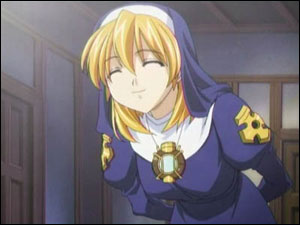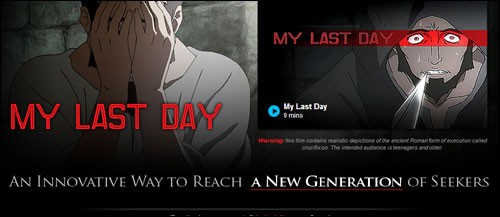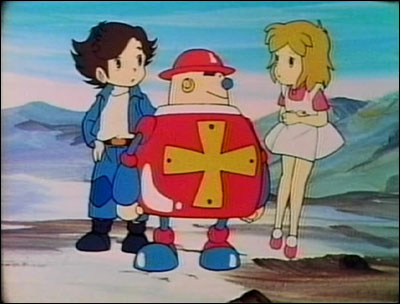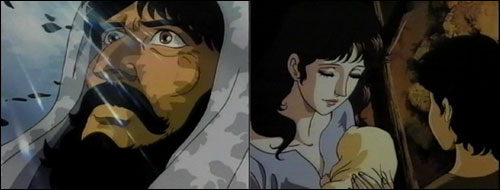The Mike Toole Show
Anime Sunday School
by Michael Toole,
Here we are, right on the cusp of 2014. Another year of watching anime, reading manga, and wasting lots of time reading and talking about it has passed us by. Along with the requisite feasting and absurd orgy of consumerism that signifies the passing of the holidays, many of us are in the midst of celebrating the birth of the one and only savior who will come to rescue us all: Space Dandy.
Well, Space Dandy is merely going to save anime, and possibly Saturday nights in general—we hope. But at the risk of inviting a spot of controversy, I think now's a good time as any for this column to get religion. Lots and lots of anime are about religion, you see. Plenty of anime is run through with ideas and symbols from Shinto—one of my favorites is Kamichu!, the tale of a young girl who suddenly finds herself manifesting the powers of one of the country's animist small gods. We've got Tezuka's chronicle of the life of Buddha, which is fabulous in manga form but less so on the big screen. Heck, there's even an anime version of the Ramayana. But as we celebrate the ad hoc birthday of Jesus Christ, let's explore some of the most interesting anime about Christianity.

I'm not a particularly religious person, but I was raised Catholic, so I've got a pretty good handle on Christian scripture, ritual, and history. I've got enough of an angle on things, for example, that I can look a bit askance at the otherwise breezy and fun Saint Tail, which features a young “apprentice nun” named Seira, who looks like a teen girl version of your typical habit-wearing nun. But the thing is, until you're ordained, you're not supposed to be wearing that habit! I guess you can't always count on anime for getting this stuff right—after all, Ghost Stories features a character who's a teenaged priest, which is about as likely as an apprentice nun. One of Saint Tail’s stock footage conceits, which involves the title character and Seira praying for forgiveness (Saint Tail, you see, is a thief—the kind who pilfers stolen goods and returns them), always makes me giggle.

Saint Tail’s gentle theological trappings are awfully tame compared to Hellsing. Now, in any story about western vampires, you're gonna run into some Christian symbols, but there are few things as nakedly absurd and hilarious as Kouta Hirano's depiction of the frequently violent rivalry between the Church of England and the Vatican, as fought by their monster-busting paramilitary wings, the Hellsing Organization and Iscariot. But this rift isn't something that Hirano just made up – the split between the Anglican Church and the Papacy thanks to Henry VIII's marital misadventures, and the brief return under heretic-burning Queen “Bloody Mary,” are matters of historical record. It's fun to watch the vampire Alucard use holy handguns against the ranting Father Alexander Anderson and his enchanted Bible Pages, but remember: there's a historical basis for their rivalry!
I don't go out of my way to be irreverent—well, not that often, anyway—but I kind of love depictions like what we see in Hellsing. Something about Christianity as crazy, exotic sorcery instead of the mundane realities of going to church and trying to stick to the Ten Commandments really entertains me. It entertains me enough that I stuck with Chrono Crusade, the story of roaring ‘20s exorcist Rosette Christopher, who only dresses kinda like a nun, and her demonic familiar/boyfriend Chrono. You won't see this one played at Bible Camp, I'm guessing - something about literally marrying the clergy and the devil, even in the service of good, seems like it wouldn't go over well. Still, the show is pretty alright, and full of amusingly churchy stereotypes, like the One Cool Priest and the really strict nun who's in charge of Rosette's assignments. A more contemporary example might be Blue Exorcist, because hey, any time you start talking about exorcists, it's gonna involve the church somehow. The twist? Our hero, Rin Okumura, isn't just a powerful exorcist in training—he's the literal son of Satan! Don't miss his interactions with a character named Mephisto Pheles; I'm going to assume that we'll get to meet Beel ze Bub and Lou Cipher further on down the road.

Fare like the above employs certain Christian symbols – the cross, the crucifix, the Bible – but it doesn't dig deeply into the history or theology. One title that does bring history into play, and specifically the history of Christianity in Japan, is Ninja Resurrection. You remember Ninja Resurrection, right? ADV Films ruffled some feathers back in the day by employing misleading ad copy that implied that it was a sequel to Ninja Scroll. It's not, because it's actually a shade closer to history than Yoshiaki Kawajiri's famed bloody ninja epic. Protagonist Jubei Yagyu was a real-life badass who taught swordsmanship to the Shogun's family and founded Japan's first secret police, and his adversary in this two-part OVA, the Christian rebel Shiro Amakusa, was also real.
Amakusa, who's also appeared in anime fare as diverse as Samurai Shodown and Rurouni Kenshin, led a 17th-century rebellion against the Tokugawa shogunate, largely in response to persecution of Japanese Christians. Amakusa and his people captured and held Hara castle against a series of sieges, only losing when their supplies ran low. Facing execution, Amakusa declared that he'd be resurrected and seek revenge in 100 years time. It didn't come to pass, but this declaration was enough to inspire novelist Futaro Yamada, whose Makai Tensho is the basis for Ninja Resurrection. In this show, you get to see Amakusa use his faith in God to call down lightning, and when he's betrayed, summon a huge goddamn dragon. It gets kind of gross later on, though-- there are some pretty gruesome resurrections, and the sadistic tone of the show makes even Hellsing seem fairly tame by comparison. The thing is, Ninja Resurrection is frequently mentioned as being awful, and I've never been on board with that; I think it got a bad rap because of a seriously rough second episode, and the fact that it never got finished. Maybe it's just the Giant Robo fan in me talking (NR's Studio Phoenix also worked on Giant Robo), but I could've done with more of Ninja Resurrection. Maybe someday it'll be… resur—you know what? Nah.
What I've talked about so far uses some Christian symbols, but doesn't dig down to the root of the religion. In this most Jesusy of times, let's get a little more Jesusy. Back in the 80s, the Campus Crusade for Christ started a project called the Jesus Film Project, with the mission to translate the 1979 Jesus feature film into as many languages as possible. Decades later, the same group, under the same banner, would commission a new way to reach young people in search of faith.

Yup. The CCC (which has since changed its name to “cru”) took a look at how popular anime was, and saw a recruitment tool. If I was a dick, I'd draw parallels to the way the Aum Shinrikyo did the exact same thing 15 years earlier, but—yeah, I guess I'm just a dick, huh? Anyway, the Aum story is one for another column. This particular Jesus cartoon is perfectly good, albeit a bit gruesome and intense, depicting the story of one of the thieves condemned to die on the cross alongside Christ. I guess it extrapolates a bit, considering that only the Gospel of Matthew really touches on who was getting crucified with Jesus. Interestingly, the whole affair was animated by Studio 4°C. You can watch it for free here.
Now it's time to tell the amazing, magical tale of a couple of kids, a robot, and time travel. In Superbook, a.k.a. Anime Parent and Child Theatre, a 1981 Tatsunoko vehicle for gentle, inoffensive Bible stories, two kids named Chris and Joy (or Sho and Azusa, if you're enough of a damn maniac to seek out the original Japanese) employ a techno-magical Bible to travel back in time to the actual stories themselves. Accompanying them is Gizmo, or as I call him, CROSS-BOT:

The cross on his chest makes it clear that Gizmo is Coptic. Anyway, since we're in the throes of Christmas, I took a look at the Christmas episode. The kids don't take a particularly direct role, but they bear witness to the angel's appearance to Mary—in this version, the angel has a scary robot voice as it proclaims that Mary is pregnant with the son of God. “How can this be?” queries Mary. “I have not been intimate with a man!” “Well,” replies the angel, “the term for it is ‘parthenogenesis,’ and it happens from time to time—“ okay, maybe that second bit doesn't happen. But the birth of Christ does happen, complete with wacky hijinks (sample dialogue: “Herod's gonna kill Jesus!” “Better warn Joseph!”), a chorus of O Come, All Ye Faithful, and a closing shot of Jesus crossing the Delaware.

See? Some of these interpretations are really interesting! With Superbook out of the way, let's move on to the amazing, magical tale of a couple of kids, a robot, and time travel. No, it ain't déjà vu—it's The Flying House, a TV series produced one year after Superbook, by the same studio no less. It's a different set of kids, you see, and this time, instead of a magical book, the time machine is a flying house with a little turret, lending the proceedings sort of a Doctor Who vibe—a vibe reinforced by the show's mad professor, who sports the memorable moniker Dr. Tokyo Time in the original Japanese version. His American name, Humphrey Fumble, isn't so bad, either. These kids, accompanied by their robot pal SIR, take a much more direct role in Bible stories. Also unlike Superbook, this show concerns itself almost exclusively with tales from the New Testament.

The Flying House’s version of the birth of Christ is considerably wackier—after bringing a bunch of strange kids back to Biblical times, Dr. Fumble loads them into a balloon without much concern and gets rid of them. The balloon soon crashes, leaving the kids unharmed but surrounded by shepherds, who mistake the kids for the Messiah! They're soon rescued by a passing Mary, who eventually introduces them to her husband, Joseph, and these three wise guys. These children actually get to be present in the manger during the birth of Jesus, which bothers me—if this is an accurate depiction of events, then why don't these kids appear in the birth scene in Superbook?! See, these kinds of continuity problems just serve to call the entire Anime Bible into question. The pope oughta call a Vatican Council to get that sorted out. The show ends with a lecture from the monotonic yet weirdly sermonizing robot.
While Superbook and The Flying House are wacky Bible stories for kids, In the Beginning takes a somewhat more serious, studied approach to the material. The story behind In the Beginning is kind of awesome—no less than the Vatican went to Italian broadcaster RAI for help getting a beautiful, accessible cartoon version of the Bible produced. This request passed across the desk of producer/director Marco Pagot, who'd worked with Hayao Miyazaki in developing Sherlock Hound. Pagot got one Osamu Tezuka involved, who got to work on a pilot. Sadly, Dr Tezuka died before the show really got into production, but the reins were passed to Osamu Deazaki, who worked his incomparable, unmistakable magic.

The show in general relies on history and narrative rather than contrived wacky robot interventions, angels, and beams of light from heaven, and the Christmas episode isn't any different—it's presented solemnly, but with no pretext towards magic or celestial bullshit. Joseph and Mary are compelled to visit Bethlehem by order of King Herrod, who's counting the people up in the name of Caesar, so that they may be more accurately taxed. Here, we see the foundation of the historical Jesus laid—he wasn't just salvation for all sinners, but specifically meant to shake Roman rule off of the Hebrew people. The Magi show up (and unlike in Superbook and The Flying House, Gaspar actually looks and dresses like he comes from India!), Christ is born, and a little kid goes up to Mary and explains that he has no gift to bring, parump-ba-bum-bum. In the Beginning is legitimately wonderful, a show that's stately but not self-important, complete with a stodgy but competent dubbed version. It's irritating to me that Superbook and The Flying House can easily be turned up on DVD, but In the Beginning can't. Should I be praying for an inexpensive box set, I wonder?
So there's a cross-section of Christian anime, plus a few shows that use Christian symbols and ideas to tell crazy stories. There's still more out there—Yoshikazu Yasuhiko created a beautiful manga about the life of Jesus, and the recent theatrical Saint Young Men film irreverently casts Christ as Odd Couple-esque roommate to a young Buddha. What sticks with me about the trinity of Christian anime—Superbook, The Flying House, and In the Beginning—is that they don't ever feel forced. If you've spent time rooting around on CBN or the video section of your local Christian bookstore, you've seen other cartoons—stuff like McGee & Me and Adventures in Odyssey. These shows tend to be heavy-handed in their messages, and the boxes and posters for them are quick to point out how they're BRINGING BIBLICAL VALUES HOME!! The anime shows don't seem to rely on this approach, and I think it helps, both in terms of general storytelling and in terms of presenting stuff from the Bible as appealing fare.
Here's my question: If you're a particularly observant Christian, does anime that treats your faith with kid gloves get on your nerves? Do you seek out Christian anime, and hope for more? Or is anime your favorite kind of escapism, something that you're happy to keep separate from religion? Sound off in the comments!
discuss this in the forum (71 posts) |